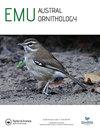人为食物资源可得性的差异是否会影响吵闹矿工(黑头马)中观察到的激动行为水平?
IF 1.1
4区 生物学
Q3 ORNITHOLOGY
引用次数: 0
摘要
吵闹的采蜜者(Manorina melanocephala)是一种生活在澳大利亚东南部的群居蜜水,表现出高水平的种间侵略,并减少了其所占据地区的鸟类生物多样性。人类引起的栖息地变化也可能增加高质量栖息地和食物资源的可用性,这可能反过来影响活动预算和矿工对其他物种的攻击持续时间或强度。为了量化人为食物资源的潜在可用性差异对噪音矿工攻击水平的影响,我们提出了三种不同类别鸟类(食物竞争对手、非食物竞争对手和潜在捕食者)的标本模型,并量化了在三种不同栖息地观察到的攻击行为。人类食物资源非常有限的自然区域,提供补充资源的花园,如富含花蜜的观赏植物,以及提供人类食物的咖啡厅。正如预测的那样,与自然区域相比,吵闹的矿工在有人为食物资源的栖息地(即花园和咖啡厅)中表现出的竞争行为明显更长。所呈现的模型类型也影响了矿工的反应,(1)矿工围攻捕食者的数量多于竞争对手的模型,(2)矿工围攻捕食者模型的时间比竞争对手的时间长,(3)矿工与竞争对手模型进行身体接触的可能性更大。这些发现表明,额外的资源有能力影响物种的时间预算,对于像吵闹的矿工这样的攻击性强的鸟类来说,它们可以以比以前量化的更细微的方式影响生物多样性。本文章由计算机程序翻译,如有差异,请以英文原文为准。
Do differences in the availability of anthropogenic food resources influence the observed levels of agonistic behaviour in Noisy Miners (Manorina melanocephala)?
ABSTRACT The Noisy Miner (Manorina melanocephala) is a cooperative honeyeater living in social groups throughout south-east Australia that displays high levels of interspecific aggression and reduces avifaunal biodiversity in areas it occupies. Human-induced habitat changes have also potentially increased the availability of high-quality habitat and food resources available for Noisy Miners, which may in turn affect activity budgets and the duration or intensity of aggression displayed by Miners towards other species. To quantify the impact of differences in the potential availability of anthropogenic food resources on Noisy Miner aggression levels, we presented taxidermy models from three different categories of bird species (food competitors, non-food competitors and potential predators) and quantified observed aggression in three separate habitats: natural areas with very limited additional anthropogenic food resources, gardens that provided supplementary resources such as nectar-rich ornamental plants, and cafés that provided access to human food items. As predicted, Noisy Miners exhibited agonistic behaviours for a significantly longer period in the habitats with anthropogenic food resources, namely gardens and cafés in comparison to natural areas. The type of model presented also impacted Miner response, with: (1) greater numbers of Miners mobbing predator rather than competitor models, (2) Miners mobbing predator models for longer periods than competitors, and (3) a greater probability of Miners physically contacting competitor models. These findings demonstrate that additional resources have the ability to impact time budgets of species and, for hyperaggressive birds such as Noisy Miners, can impact biodiversity in more nuanced ways than previously quantified.
求助全文
通过发布文献求助,成功后即可免费获取论文全文。
去求助
来源期刊

Emu-Austral Ornithology
生物-鸟类学
CiteScore
2.00
自引率
7.70%
发文量
33
审稿时长
>12 weeks
期刊介绍:
Emu – Austral Ornithology is the premier journal for ornithological research and reviews related to the Southern Hemisphere and adjacent tropics. The journal has a long and proud tradition of publishing articles on many aspects of the biology of birds, particularly their conservation and management.
 求助内容:
求助内容: 应助结果提醒方式:
应助结果提醒方式:


